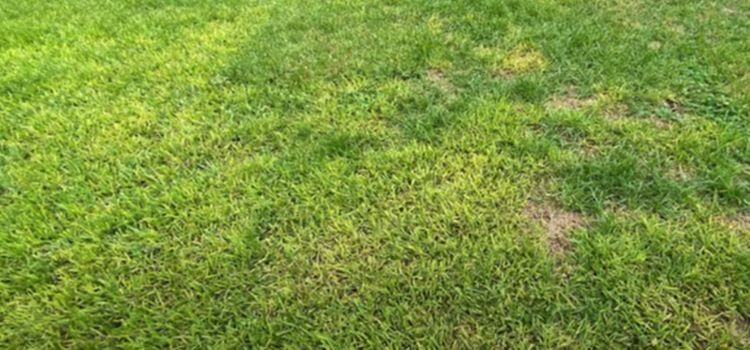As an Amazon Associate, I earn from qualifying purchases.
St. Augustine grass is a famous option for lawns in warm climates. Its lush, green blades can turn heads, but when they start to highlight a yellow hue, it’s not quite the look you’re going for.
You’re not alone if you’re facing the disheartening sight of yellowing St. Augustine grass. This issue can stem from various causes, and understanding them is vital in nursing your lawn back to health. This post guides why my St Augustine grass is turning yellow.
Augustine Grass
St. Augustine is a popular warm-season grass that performs best in well-draining soils with an acidic to neutral pH. St. Augustine grass is often considered a high-maintenance species. It requires vital care to maintain its health.
When this vibrant green grass starts to yellow, it’s a clear sign that something isn’t right. The key is to identify the cause as quickly as possible, and we’re here to help you do just that.
Its broad blades and rapid growth rate make it a well-loved feature in many homes. However, neglect or incorrect care can lead to the grass turning an undesirable shade of yellow.
It requires full sun to maintain its green hue and thrives during summer.
Why is my St Augustine grass turning yellow?
When St. Augustine grass turns yellow, there can be many culprits; often, it’s a combination of issues at play.
Lack of Sunlight
Your St. Augustine grass may start to yellow if it lacks sunlight. This can happen when trees grow too close, or your landscape design shades the grass.
Solutions
- Prune Trees: Light trimming can allow more sunlight to reach the grass without harming the trees or landscape.
- Evaluate Your Landscaping: Reconsider any structures causing shade and relocate if possible.
- Choose the Right Seed: Opt for a shade-tolerant variety if planting or reseeding.
Overwatering
Yellowing can also occur if your St. Augustine grass is drowning from too much love in the form of overwatering.
Solutions
- Adjust Watering Schedule: Ensure that you’re watering sparingly. Allow the grass to dry out between watering to prevent root rot.
- Proper Drainage: Address any drainage issues that might be causing the soil to retain excess water.
- Water in the Mornings: This allows the water to be absorbed before the day’s heat can evaporate it.
Under-fertilization
A diet lacking essential nutrients can cause your grass to turn yellow. Most often, a lack of nitrogen is the root of the problem.
Solutions
- Choose the Right Fertilizer: Always use a high nitrogen content fertilizer suitable for St. Augustine grass.
- Follow Proper Schedule: Fertilize according to your lawn’s needs and as agricultural extension services recommend.
- Avoid Skimping: Sometimes, it’s as simple as not using enough fertilizer. Please don’t be shy when feeding your lawn, but be cautious not to overdo it.
Soil pH Imbalance
If the soil pH is too high or too low, your grass may struggle to absorb nutrients from the ground, showing a yellow appearance.
Solutions
- Test Your Soil: Use a soil test tool to determine your pH.
- Use Lime or Sulfur To raise or lower the pH after testing the soil.
- Balance Fertilizer with Lime: If fertilizing with a high-nitrogen blend, consider using lime to counteract acidity.
Pest Infestation
Insects can be incredibly damaging to any lawn and cause specific areas to turn yellow.
Solutions
- Detect the Infestation: Check for signs of common lawn pests, like chinchbugs or armyworms.
- Act Fast: Use appropriate insecticides and follow their instructions diligently.
- Consider Natural Predators: Some animals may be brought in to naturally deal with more significant pests.
Disease or Fungal Infection
Pests, diseases, and fungi can cause discoloration and patchy yellowing of the lawn.
Solutions
- Recognize the Symptoms: Different diseases cause different types of damage, so identify the issue first.
- Apply Fungicides: Once diagnosed, apply the appropriate fungicide or remedy, such as neem oil, for more natural solutions.
- Aerate the Soil: Promote good airflow and reduce humidity to discourage fungal growth.
Improper Mowing Practices
Mowing too often or cutting the grass too short can stress the lawn and cause it to turn yellow.
Solutions
- Adjust Your Mowing Height: Raise the mower deck to the recommended height for St. Augustine grass, usually around 3-4 inches.
- Sharpen Your Blades: Dull blades tear the grass, making it susceptible to disease and pests.
- Leave the Clippings: Grass clippings can be a natural fertilizer, so consider leaving them on the lawn after mowing.

FAQ: Why is my St Augustine grass turning yellow?
Several factors can cause St. Augustine grass to turn yellow, including nutrients, pests, diseases, watering issues, etc. It’s essential to diagnose the specific cause to address the problem effectively.
A lack of crucial nutrients like nitrogen, iron, or potassium can lead to yellowing. A balanced fertilizer formulated for St. Augustine grass can often rectify this issue.
Pests like chinch bugs, grubs, and sod webworms can damage your lawn, leading to yellow spots or patches. Check your lawn for pests and treat them with appropriate pesticides or natural solutions.
St. Augustine grass is sensitive to several diseases, like take-all root rot, brown patches, and gray leaf spots, which can cause yellowing. Identifying the disease is crucial in choosing the correct treatment.
Conclusion
Nurturing a healthy St. Augustine lawn involves consistent care and vigilance. Common issues that cause yellowing and actively addressing them. You’ll be well on your way to a vibrant, green expanse. Regular maintenance and a vigilant eye will keep your St. Augustine grass looking its best.

